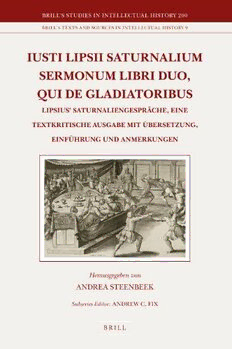
Iusti Lipsii Saturnalium Sermonum libri duo, qui de gladiatoribus: Lipsius' Saturnaliengespräche, eine textkritische Ausgabe mit Übersetzung, Einführung und Anmerkungen PDF
487 Pages·2011·2.401 MB·German
Most books are stored in the elastic cloud where traffic is expensive. For this reason, we have a limit on daily download.
Preview Iusti Lipsii Saturnalium Sermonum libri duo, qui de gladiatoribus: Lipsius' Saturnaliengespräche, eine textkritische Ausgabe mit Übersetzung, Einführung und Anmerkungen
Description:
Thema von Lipsius Saturnaliengespräche (1582) sind die Gladiatorenspiele. Alle Aspekte werden beleuchtet, zum Beispiel, welche Arten Gladiatoren es gab: da waren Kriminelle, aber auch hohe Beamte dabei, die manchmal freiwillig als Gladiatoren funktionierten. Die detaillierte Beschreibung schließt gut an bei seinen anderen historiographischen Werken, wie De Amphitheatro (1584). Am Ende der Saturnaliengespräche steht eine schwungvolle Rede über die bewundernswerten Beständigkeit der Gladiatoren. Lipsius spricht in verschiedenen Briefen über sie als leuchtende Vorbilder. Das passt zu seinem Vorhaben, die Stoa von Neuem bekannt zu machen. Er hatte dabei Erfolg, denn seine stoische Lehre erhielt viel Zuhörerschaft. De Constantia, das er 1584 zum ersten Mal publizierte, erfuhr zahllose Auflagen und Übersetzungen.In his Saturnalian dialogues (1582), Lipsius describes all aspects of gladiatorial combat, for example, that a great variety of people criminals but also highly placed officials took part in the combats, sometimes as volunteers. This detailed description fits into Lipsius other historiographical works, such as De Amphitheatro, published in 1584. After an elaborate exposition about gladiators, in the last chapter of the Saturnalian dialogues he gives an impassioned speech about their admirable constancy despite extremely hard circumstances. In several letters, Lipsius also refers to gladiators as proper models to be imitated. His main aim, here and elsewhere, was the promotion of his Stoic ethic a goal that would ultimately prove successful: De Constantia, first published in 1584, has gone through a large number of reprints, editions and translations.
See more
The list of books you might like
Most books are stored in the elastic cloud where traffic is expensive. For this reason, we have a limit on daily download.
